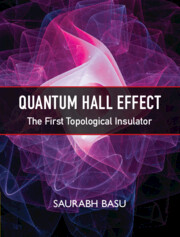Book contents
- Frontmatter
- Dedication
- Contents
- Foreword
- Preface
- Acknowledgements
- 1. Quantum Hall Effect
- 2. Symmetry and Topology
- 3. Topology in One-Dimensional (1D) and Quasi-1D Models
- 4. Quantum Hall Effect in Graphene
- 5. Graphene as a Topological Insulator: Anomalous Hall Effect
- 6. Fractional Quantum Hall Effect
- Epilogue
- Bibliography
- Index
6. - Fractional Quantum Hall Effect
Published online by Cambridge University Press: aN Invalid Date NaN
- Frontmatter
- Dedication
- Contents
- Foreword
- Preface
- Acknowledgements
- 1. Quantum Hall Effect
- 2. Symmetry and Topology
- 3. Topology in One-Dimensional (1D) and Quasi-1D Models
- 4. Quantum Hall Effect in Graphene
- 5. Graphene as a Topological Insulator: Anomalous Hall Effect
- 6. Fractional Quantum Hall Effect
- Epilogue
- Bibliography
- Index
Summary
Introduction
The fractional quantum Hall effect (FQHE) was discovered by Tsui, Stormer and Gossard in 1982 at Bell Labs. They observed that at very high magnetic fields, a 2DEG shows fractional quantization of the Hall conductance. In particular, they got a quantized Hall plateau of magnitude ρxy = 3h/e2, which is accompanied by the vanishing of the longitudinal conductivity, ρxx, at low temperature (T < 5 K) in GaAs and AlGaAs samples. As opposed to the integer quantum Hall effect (IQHE), where an integer number of Landau levels (LLs) are occupied, here in FQHE the LLs are partially occupied. If onemakes themagnetic field large enough, the lowest Landau level (LLL) will be partially filled. Whatwe can expect is that the system will form some kind of a lattice, for example, a Wigner crystal or a charge density wave. Thus, it naively seems to be reasonable that the system would like to minimize its potential energy, since there is no kinetic energy left in the system corresponding to the LLL, and only a trivial zero point energy is present in the system. Thus, the ions tend to stay away from each other and form something similar to a crystal lattice. However, surprisingly that does not happen, and instead the system becomes an incompressible quantum liquid, which has gaps in the energy spectrum at filling 1/m (m: odd, or a rational fraction of the form n/m). So it is inevitable that the systemminimizes its energy by having gaps at fractional values of filling. The reason is that, owing to the presence of a large number of electrons (macroscopically degenerate in any of the LLs), a many-body interaction is induced, which in fact makes the excitations above this incompressible ground state to be fractional. So in essence, the Hall current carries a fractional charge.
- Type
- Chapter
- Information
- Quantum Hall EffectThe First Topological Insulator, pp. 173 - 206Publisher: Cambridge University PressPrint publication year: 2024



